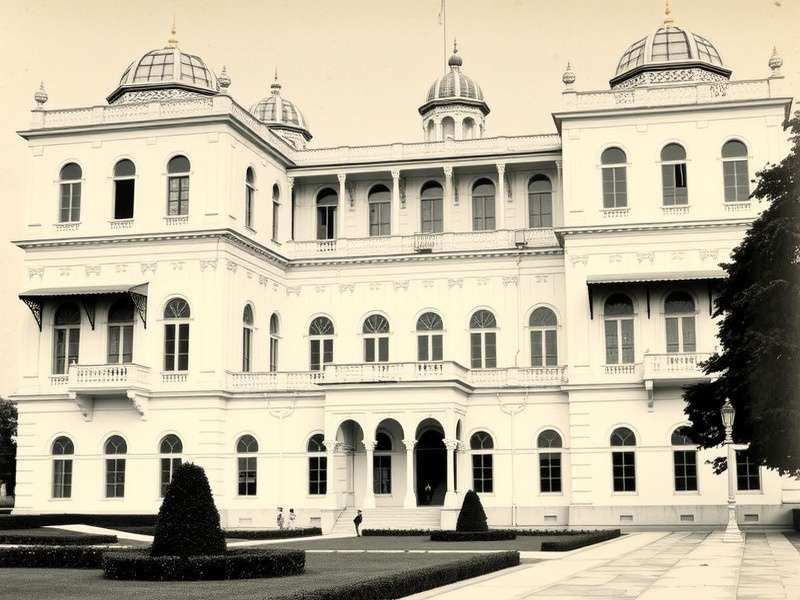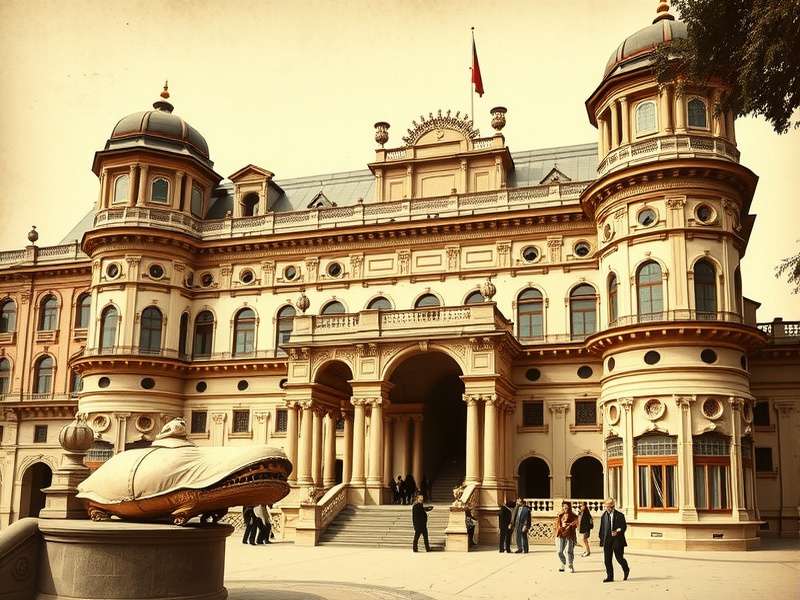Overview of Royal Palace Of Kapurthala
✨ Quick Facts:Also known as Jagatjit Palace • Built between 1900-1908 • French Renaissance & Indo-Saracenic style • Spread over 200 acres
TheRoyal Palace Of Kapurthalastands as one of Punjab's most magnificent architectural wonders, often referred to as the "Versailles of India" due to its striking resemblance to the Palace of Versailles in France. This majestic structure represents a unique blend of European elegance and Indian grandeur, creating an unforgettable visual spectacle.
Located in the heart of Kapurthala city, this palace was the official residence of the erstwhile Maharaja of Kapurthala and continues to be a symbol of the region's rich cultural heritage. TheRoyal Palace Of Kapurthalashowcases the visionary approach of its creators who sought to bring European architectural sophistication to Indian soil.

The stunning facade of Royal Palace Of Kapurthala showcasing French Renaissance architecture with Indian elements
Today, the palace serves multiple functions - part of it houses the Sainik School, while other sections are open to tourists who wish to experience the opulence of India's royal past. The maintenance and preservation ofRoyal Palace Of Kapurthalaremains a priority for both the government and heritage conservation organizations.
Historical Background
Did You Know?The construction of Royal Palace Of Kapurthala took 8 years to complete and employed over 1000 artisans from across India and Europe.
The genesis ofRoyal Palace Of Kapurthaladates back to the early 20th century when Maharaja Jagatjit Singh, the then ruler of Kapurthala State, envisioned creating a palace that would rival the great European palaces he had visited during his extensive travels. Inspired particularly by the Palace of Versailles, he commissioned French architect M. Marcel to design his dream residence.
Construction Timeline
1900-1902: Planning & Design Phase
Extensive planning and design development took place during this period. Maharaja Jagatjit Singh worked closely with architect M. Marcel to create blueprints that combined French Renaissance architecture with local building techniques and materials.
1903-1906: Main Construction
The primary structure of the palace was erected during these years. Skilled artisans from Jaipur, Lahore, and other regions were brought in to work alongside European craftsmen, creating a unique fusion of artistic styles.
1907-1908: Interior Decoration & Landscaping
The final years focused on elaborate interior decorations, including intricate woodwork, marble inlays, and the creation of magnificent gardens inspired by French landscape design principles.
Throughout its history, theRoyal Palace Of Kapurthalahas hosted numerous dignitaries, including British viceroys, European royalty, and prominent political figures. The palace witnessed the transition of India from princely states to an independent nation, adapting to changing political landscapes while maintaining its architectural integrity.

Historical photograph showing Royal Palace Of Kapurthala in its early years with original landscaping
Architectural Marvel
TheRoyal Palace Of Kapurthalarepresents an extraordinary example of cross-cultural architectural synthesis. The primary style is French Renaissance, characterized by its symmetrical facades, mansard roofs, and elaborate ornamentation. However, the architects skillfully incorporated elements of Indo-Saracenic architecture to adapt to the local climate and cultural context.
Key Architectural Features
Exterior Design
The palace features grey sandstone facades with intricate carvings, tall arched windows, and distinctive French-style turrets. The symmetrical layout creates a sense of balance and grandeur that is visually striking from every angle.
Interior Splendor
Inside, the palace boasts magnificent ballrooms, grand staircases, and reception halls adorned with Italian marble, Belgian stained glass, and exquisite woodwork. The Durbar Hall is particularly notable for its gold leaf decorations and intricate ceiling work.
Gardens & Landscape
The palace is surrounded by beautifully manicured gardens featuring fountains, water channels, and ornamental plants arranged in geometric patterns inspired by French formal gardens, yet incorporating native Indian flora.
Cultural Fusion Elements
Despite its predominantly French design, the architecture includes Mughal-style jali work, traditional Indian courtyards, and local building materials that reflect the regional context and ensure climatic appropriateness.
The architectural brilliance ofRoyal Palace Of Kapurthalalies not just in its aesthetic appeal but also in its functional design. The building incorporates traditional Indian methods of temperature control, with thick walls, high ceilings, and strategic window placements that ensure comfortable interiors despite Punjab's extreme climate.

Detailed view showing the intricate architectural elements that make Royal Palace Of Kapurthala unique
Cultural & Historical Significance
TheRoyal Palace Of Kapurthalaholds immense cultural and historical significance that extends far beyond its architectural value. It represents a pivotal period in Indian history when traditional princely states were engaging with global influences while maintaining their cultural identity.
Symbol of Cultural Synthesis
This magnificent structure stands as a testament to the cosmopolitan outlook of the Kapurthala rulers, particularly Maharaja Jagatjit Singh, who was known for his progressive views and international exposure. TheRoyal Palace Of Kapurthalaembodies the idea that cultural exchange can produce something truly extraordinary rather than resulting in cultural dilution.
🏛️ Heritage Status:The Royal Palace Of Kapurthala is recognized as a Grade I heritage building by the Indian National Trust for Art and Cultural Heritage (INTACH) and is protected under the Punjab Ancient and Historical Monuments and Archaeological Sites and Remains Act.
Educational & Tourism Value
Today, the palace serves as an important educational resource, offering insights into architectural history, royal lifestyles, and cultural interactions between India and Europe. For tourists, both domestic and international, theRoyal Palace Of Kapurthalaprovides a unique opportunity to experience a slice of India's royal heritage in a setting that bridges Eastern and Western aesthetic traditions.
The ongoing preservation efforts for theRoyal Palace Of Kapurthalademonstrate a commitment to safeguarding India's diverse architectural legacy for future generations. These conservation initiatives balance the need for structural integrity with respect for historical authenticity.
Visitor Information
Planning a visit to the magnificentRoyal Palace Of Kapurthalarequires some basic information to make the most of your experience. This section provides essential details for tourists and history enthusiasts interested in exploring this architectural gem.
Visiting Hours
- Monday - Friday:9:00 AM - 5:00 PM
- Saturday:9:00 AM - 5:00 PM
- Sunday:10:00 AM - 4:00 PM
- Holidays:Special timings may apply
Entry Information
- Indian Citizens:₹50 per person
- Foreign Tourists:₹500 per person
- Children (under 12):Free entry
- Photography:Permitted (no flash)
💡 Pro Tip:The best time to visit Royal Palace Of Kapurthala is during the winter months (October to March) when the weather is pleasant for exploring the extensive gardens and outdoor areas.
How to Reach
Kapurthala is well-connected by road to major cities in Punjab. The nearest railway station is Jalandhar City (approximately 20 km away), and the closest airport is Sri Guru Ram Dass Jee International Airport in Amritsar (about 75 km from Kapurthala). Local transportation including taxis and auto-rickshaws are readily available for reaching theRoyal Palace Of Kapurthalafrom these transit points.
Nearby Attractions
While visiting theRoyal Palace Of Kapurthala, tourists can also explore other significant sites in the region including the Moorish Mosque (inspired by Moroccan architecture), Shalimar Bagh, and the State Gurudwara. These complementary attractions provide a more comprehensive understanding of Kapurthala's rich cultural tapestry.